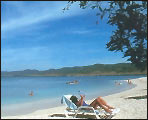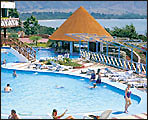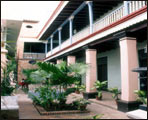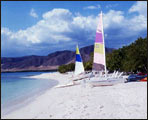|
Today, Bayamo is a city that zealously  keeps
its traditions. There is a historical center in the place where
the National hymn was sung for the first time. In the parochial
church of San Salvador de Bayamo, they have preserved a fresco
with patriotic motifs, only one of its kind in Cuba. keeps
its traditions. There is a historical center in the place where
the National hymn was sung for the first time. In the parochial
church of San Salvador de Bayamo, they have preserved a fresco
with patriotic motifs, only one of its kind in Cuba.
Numerous places of interest can be visited in this city, declared
National Monument: the natal house of Carlos Manuel de Céspedes,
Founding Father; the Santo Domingo convent or the window of Luz
Velázquez where "La Bayamesa", considered the
first song of Cuban "trova", was sung for the first
time.
 This
province treasures almost half of all historical sites in Cuba.
Places so important in Cuban History such as Dos Ríos,
where a monument rises in the place where our Apostle and National
Hero, José Martí, died in combat on May 19th,1895,
and the ruins of the sugar mill La Demajagua, where the first
steps of the Ten-Year War (1868-1878) were taken. This
province treasures almost half of all historical sites in Cuba.
Places so important in Cuban History such as Dos Ríos,
where a monument rises in the place where our Apostle and National
Hero, José Martí, died in combat on May 19th,1895,
and the ruins of the sugar mill La Demajagua, where the first
steps of the Ten-Year War (1868-1878) were taken.
In the geography of the province, the western end of the Sierra
Maestra, made National Park, has a great signification owing to
its ecological importance and historical value. It is worth-mentioning
that the quest  for
national liberation took place in those mountains. In this National
Park, is located the main tourist center in Granma: Marea del
Portillo, a beach of quiet and transparent waters and brown sands,
which delights the visitor due to the beauty of the mountain landscape
behind it. In addition, there are 17 spots for snorkeling and
diving and options like the excursion to Cayo Blanco. for
national liberation took place in those mountains. In this National
Park, is located the main tourist center in Granma: Marea del
Portillo, a beach of quiet and transparent waters and brown sands,
which delights the visitor due to the beauty of the mountain landscape
behind it. In addition, there are 17 spots for snorkeling and
diving and options like the excursion to Cayo Blanco.
The Desembarco del Granma National Park is another tourist attraction
of this province. Its system of marine terraces is the best preserved
of the archipelago. That is the reason why it has been recognized
by UNESCO as one of the  most
representative of the world. In this park are worth-visiting the
hole of Morlotte, 77 m (253 ft) deep and 52 m (171 ft) wide, and
the Fustete cave, places where more than two hundred species of
Cuban flora have been identified. most
representative of the world. In this park are worth-visiting the
hole of Morlotte, 77 m (253 ft) deep and 52 m (171 ft) wide, and
the Fustete cave, places where more than two hundred species of
Cuban flora have been identified.
A historical site recalling the route followed by the members
of the Granma yacht expedition, which commanded by Fidel Castro
disembarked in this site on December 2nd, 1956, has been preserved.
Thus, the visitor can go over the 22 km (14 mi) between the disembark
point and Alegría de Pío, where the first combat
with troops of the Batista regime took place.
|